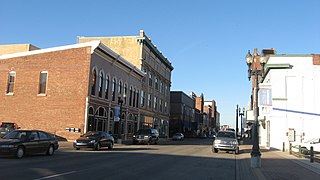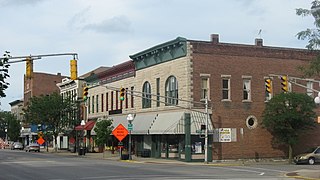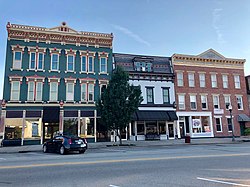
The Elwood Downtown Historic District is a national historic district located at Elwood, Madison County, Indiana. The district encompasses 51 contributing buildings and 1 contributing object in the central business district of Elwood. It developed between about 1887 and 1952, and includes notable examples of Late Victorian, Romanesque Revival, Neoclassical, and Art Deco style architecture. Notable buildings include the Calloway Block, Dehority Block (1894), St. Joseph Catholic Church (1899), United Methodist Church (1899), U.S. Post Office (1911), Carnegie Library (1901), former Elwood City Hall (1899), the Leeson's Building, and the Opera House.

The Greensburg Downtown Historic District is a national historic district located at Greensburg, Decatur County, Indiana. It encompasses 67 contributing buildings and 3 contributing objects in the central business district of Greensburg. The district developed between about 1854 and 1945, and includes notable examples of Italianate, Queen Anne, and Classical Revival style architecture. Located in the district are the separately listed Decatur County Courthouse and Knights of Pythias Building and Theatre. Other notable buildings include the Palmer Building, YMCA (1915), City Hall (1874), U.S Post Office, George E. Erdmann Building (1908),.

Hamline Chapel, United Methodist Church is a historic Methodist church located at High and Vine Streets in Lawrenceburg, Dearborn County, Indiana. It was built about 1847, and is a one-story, gable front, Greek Revival style brick building on a raised basement. A rear addition was built about 1900 and two-story Sunday School and office addition in the 1950s. The church was renovated in 1979.

Geneva Downtown Commercial Historic District is a national historic district located at Geneva, Adams County, Indiana, USA. It encompasses 22 contributing buildings in the central business district of Geneva. were built between about 1882 and 1930, and include notable examples of Italianate and Romanesque Revival style commercial architecture. Notable buildings include the M.E. Hutton Carriage Shop (1895-1896), Briggs Hardware (1882), Shamrock Block, and the Independent Order of Odd Fellows building (1906).

Brazil Downtown Historic District is a national historic district located at Brazil, Clay County, Indiana. The district encompasses 35 contributing buildings and two contributing objects in the central business district of Brazil. The district developed between about 1875 and 1935, and includes notable examples of Italianate, Romanesque Revival, and Renaissance Revival style architecture. Located in the district is the separately listed United States Post Office. Other notable buildings include the Sinclair Oil Gas Station, Lark Theater, Citizens Bank Building, Brazil Trust Company, D.H. Davis Building (1909), and Telephone Building.

Dearborn County Courthouse is a historic courthouse located at Lawrenceburg, Dearborn County, Indiana. It was built in 1870–71, and is a three-story, five bay, Greek Revival style building constructed of limestone. It features a three bay pedimented portico with four fluted columns with Corinthian order capitals.

Vance-Tousey House is a historic home located at Lawrenceburg, Dearborn County, Indiana. It was built about 1818, and is a two-story, five bay, Late Georgian / Federal style brick and sandstone dwelling with a low hipped roof. The main block is flanked by 1+1⁄2-story wings. Flanking the main entrance are fluted Doric order engaged columns above which is a Palladian window. It was built by Samuel C. Vance, founder of the town of Lawrenceburg. It houses the Dearborn County Historical Society.

Downtown Aurora Historic District is a national historic district located at Aurora, Dearborn County, Indiana. The district encompasses 272 contributing buildings, 1 contributing site, and 3 contributing structures in the central business district of Aurora. The district developed between about 1830 and 1944, and includes notable examples of Italianate, Federal, and Greek Revival style architecture. Located in the district are the separately listed Aurora City Hall, Aurora Methodist Episcopal Church, Aurora Public Library, First Evangelical United Church of Christ, First Presbyterian Church, George Street Bridge, Hillforest, Lewis Hurlbert, Sr. House, Leive, Parks and Stapp Opera House, and George Sutton Medical Office. Other notable buildings include the T. and J.W. Gaff Distillery (1843), First National Bank (1924), I.O.O.F. Hall (1887), B&O Railroad Station (1911-1917), John Neff Building, Chamber Stevens & Co. Dry Goods Store, U.S. Post Office (1935), Star Milling Co. (1891), and St. John's Evangelical Lutheran Church (1874).

Downtown Auburn Historic District is a national historic district located at Auburn, DeKalb County, Indiana. The district encompasses 52 contributing buildings in the central business district of Auburn. The district developed between about 1870 and 1935, and includes notable examples of Victorian, Classical Revival, Romanesque Revival, and Colonial Revival style architecture. Notable buildings include the DeKalb County Courthouse (1911-1914), Henry Opera House (1917), DeKalb County Jail (1918), Commercial Club (1917), Auburn City Hall (1913), South Interurban Station, Dilgard Building, Y.M.C.A. Building (193-1914), Auburn Hotel (1922), U.S. Post Office (1934), and Masonic Temple.

Downtown Butler Historic District is a national historic district located at Butler, DeKalb County, Indiana. The district encompasses 30 contributing buildings in the central business district of Butler. The district developed between about 1860 and 1950, and includes notable examples of Italianate and Early Commercial style architecture. Notable buildings include the Butler Carnegie Library (1916), Marshall Clothing Company, Old Dimestore (1863), First National Bank Building (1913), Butler Hotel (1914), Oberlin Building (1907), Towne Hardware / Broadway Cafe Buildings (1880s), Thompson Block (1903), and Mutzfeld Building (1912).

Goldsmith C. Gilbert Historic District is a national historic district located at Muncie, Delaware County, Indiana. It encompasses 75 contributing buildings and is located in the oldest residential section of Muncie. The district includes notable examples of Late Victorian, Colonial Revival, and Bungalow / American Craftsman style architecture. Located in the district is the separately listed J.C. Johnson House. Other notable buildings include the A.L. Johnson House, Meeks Mortuary Building, Joseph Hummel House, and Miller Livery (1916).

Walnut Street Historic District is a national historic district located at Muncie, Delaware County, Indiana. It encompasses 66 contributing buildings and 1 contributing object, and is located in the central business district of Muncie. The district includes notable examples of Italianate, Late Victorian, Colonial Revival, and Beaux-Arts style architecture. Located in the district are the separately listed Moore-Youse-Maxon House, Roberts Hotel, and Goddard Warehouse. Other notable buildings include the Patterson Bock, McNaughton Block (1901-1903), Mitchell Block (1909), American National Bank Building (1924), Marsh Block (1888), and the Old Post Office designed by the Office of the Supervising Architect under James Knox Taylor.

Elkhart Downtown Commercial Historic District is a national historic district located at Elkhart, Elkhart County, Indiana. The district encompasses 59 contributing buildings in the central business district of Elkhart. It was developed between about 1868 and 1930, and includes notable examples of Italianate, Queen Anne, and Classical Revival style architecture. Located in the district are the separately listed Green Block, Lerner Theatre, and Young Women's Christian Association. Other notable buildings include the Cornish Block, Franklin Street Station (1895), Menges Building (1908), former Post Office (1905), Midwest Museum of Modern Art (1922), Elkhart Water Company, Masonic Temple, Rowe Block (1900), and Dreves Building.

Downtown Nappanee Historic District is a national historic district located at Nappanee, Elkhart County, Indiana. The district encompasses 26 contributing buildings in the central business district of Nappanee. It was developed between about 1874 and 1939, and includes notable examples of Italianate and Classical Revival style architecture. Notable buildings include the Bechtel Building (1888), U.S. Post Office, Dietrich Block, Kaufman's Department Store (1902), First National Bank, Yoder's Garage, B&O Depot, Hartman Brothers Building, and Farmers and Traders Bank (1915).

Attica Downtown Historic District is a national historic district located at Attica, Fountain County, Indiana. The district encompasses 50 contributing buildings in the central business district of Attica. It developed between about 1840 and 1942, and includes notable examples of Art Deco, Gothic Revival, and Classical Revival style architecture. Notable buildings include the U.S. Post Office (1935) designed by the Office of the Supervising Architect under Louis A. Simon, McDonald House (1840), Revere Hotel (1853), and I.O.O.F Building.

Marion Downtown Commercial Historic District is a national historic district located at Marion, Grant County, Indiana. It encompasses 52 contributing buildings, 2 contributing structures, and 1 contributing object in the central business district of Marion. It developed between about 1870 and 1942, and includes notable examples of Italianate, Romanesque, and Classical Revival style architecture. Located in the district is the separately listed Grant County Jail and Sheriff's Residence. Other notable buildings are the Grant County Courthouse (1881-1883), Marion Bank Building, Iroquois Building, Dan-Mar Apartments, United Telephone Block, Cecelian Apartments, Marion Post Office, and William Smith Building / Mecca Club.

North Vernon Downtown Historic District is a national historic district located at North Vernon, Jennings County, Indiana. It encompasses 80 contributing buildings and 1 contributing structure in the central business district of North Vernon. The district developed between about 1852 and 1955, and includes notable examples of Federal, Italianate, Classical Revival, and Bungalow / American Craftsman style architecture. Notable contributing buildings include the First Christian Church, M.T. Lindley Building (1891), N.C. Bank, Masonic Lodge (1899), Red Man Lodge #99, Jennings County Carnegie Library (1920), Bantz Building, Ades Building (1913), Perry-Verbiage Building, Couchman Building, and Gottwalles Grocery (1893).

Ellettsville Downtown Historic District is a national historic district located at Ellettsville, Monroe County, Indiana. The district encompasses 50 contributing buildings in the central business district and surrounding residential sections of Ellettsville. It developed between about 1840 and 1953, and includes notable examples of Queen Anne, Early Commercial, Gothic Revival, and Bungalow/American Craftsman style architecture. Notable buildings include the Robert Stimson House, May Presley House, Bradford House, George W. Fletcher House, Wickens House (1909), Capt. Gilbert Perry House, I.O.O.F. Building, Town Hall (1927), Masonic Building (1895), Knights of Pythias Building, First United Methodist Church (1900), and First Baptist Church (1909).

Kendallville Downtown Historic District is a national historic district located at Kendallville, Noble County, Indiana. The district encompasses 45 contributing buildings in the central business district of Kendallville. It developed between about 1863 and 1940, and includes notable examples of Italianate, Queen Anne, Romanesque Revival, Classical Revival, and Bungalow / American Craftsman style architecture. Located in the district is the separately listed Iddings-Gilbert-Leader-Anderson Block. Other notable buildings include the City Hall (1914), Diggins Building (1892), Masonic Hall Building, and Bernhalter Building.

Mount Vernon Downtown Historic District is a national historic district located at Mount Vernon, Posey County, Indiana. The district encompasses 39 contributing buildings, 2 contributing sites, 1 contributing structure, and 2 contributing objects in the central business district of Mount Vernon. It developed between about 1850 and 1953, and includes notable examples of Italianate, Queen Anne, Romanesque Revival, and Classical Revival style architecture. Located in the district is the separately listed Posey County Courthouse Square. Other notable contributing resources include the McFadin Cemetery, Sherburne Park, the Armory (1922), the Alexandrian (Carnegie) Library (1905), City Hall (1893), Fogas Building (1880), Palace Soda Shop, Memorial Coliseum (1925), and the Opera House (1879).
























